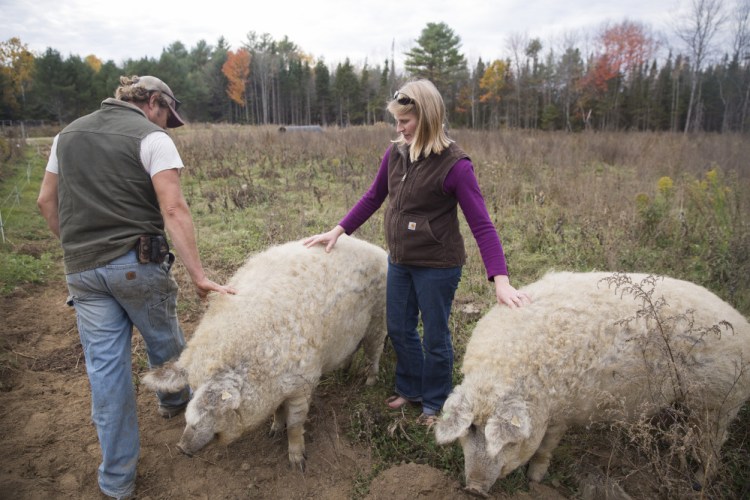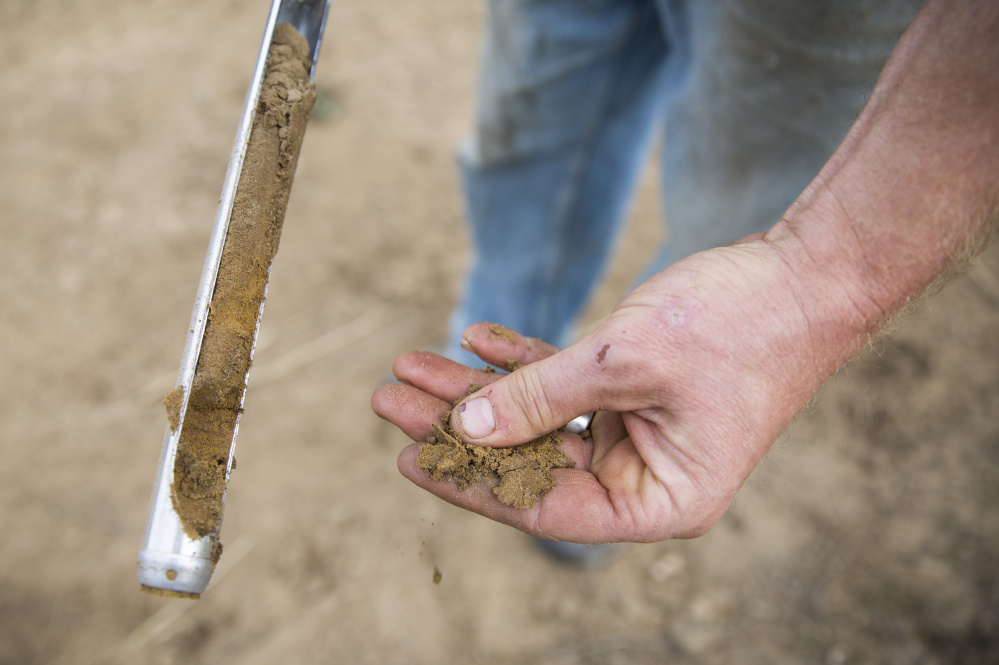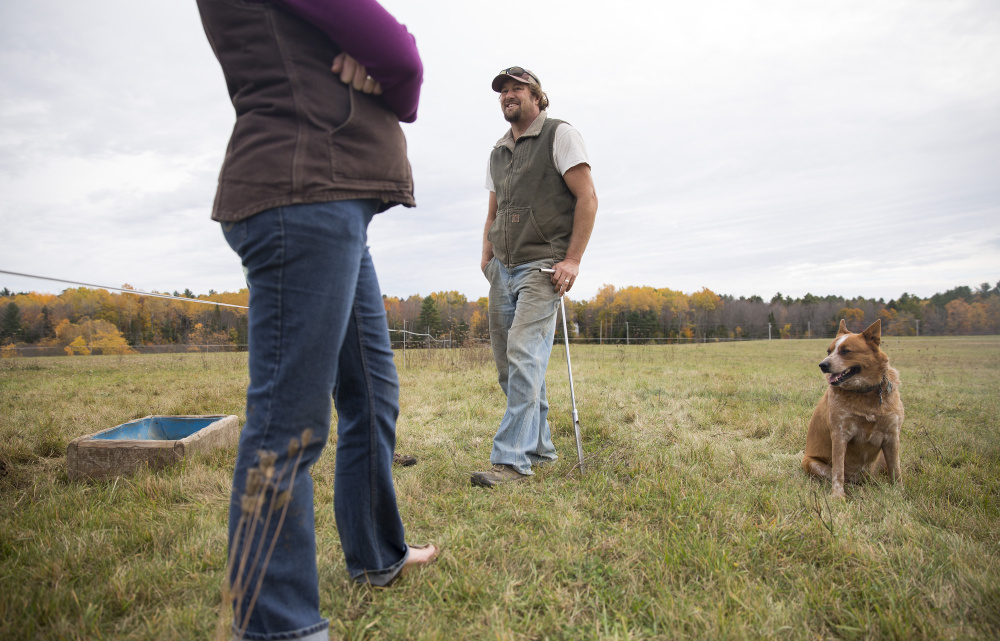DURHAM — Steve Sinisi pokes a soil probe 8 inches into the earth and pulls up dust. “It’s like powder,” he says, sifting the dry soil between his fingers. “Dry as a bone.”
With the most severe drought in Maine in more than a decade worsening, hundreds of farmers and livestock producers may be eligible for disaster assistance and low-interest loans through the U.S. Department of Agriculture. Sinisi and his wife, Seren, began the application process Thursday, hoping they qualify so they can buy feed for their cattle this winter.
“No matter what, we’re going to feed our animals,” Steve Sinisi said. “I’m just not sure how yet. Help is always a great thing.”
According to U.S. Drought Monitor data released Thursday, almost 70 percent of the state is experiencing drought conditions, including large parts of northern and eastern Maine that previously were not affected. Roughly 1.2 million people, almost the state’s entire population, are living in drought conditions.
Extreme and severe drought conditions continue in the southern third of the state, including parts of Androscoggin County, where the Sinisis live, and have not spread significantly in the past three weeks. However, the area experiencing moderate drought conditions tripled in size in the past seven days, from 14 percent of the state to almost 43 percent. Most of Oxford, Franklin, Somerset, Piscataquis, Penobscot, Hancock and Washington counties are now affected by drought, according to the Drought Monitor.
The Maine State Farm Service Agency is contacting farmers in York, Cumberland, Oxford, Androscoggin, Kennebec and Sagadahoc counties to let them know they may be eligible for disaster assistance or loans through a variety of USDA programs.
One of them is the Livestock Forage Disaster Program, which compensates livestock producers who have suffered grazing losses because of drought. The Sinisis were not able to grow enough forage to feed their cattle this winter at their 70-acre farm in Durham. They raise beef, pork and poultry at the Old Crow Ranch, and usually put up about 255 bales of hay to feed roughly 50 head of cattle through the winter. This year they have about 170 bales, which should last through February, Sinisi said.
He’ll buy the rest, and will supplement the existing hay supply with alfalfa because of the poor forage quality of the hay. The disaster relief program will pay for the hay and alfalfa he has to purchase.
Sinisi doesn’t know how much money he will spend on feed or how much of his expenses may be covered through the USDA programs. He estimates the drought will cost him at least a few thousand dollars, but it’s hard to predict because food sources are in short supply because of the drought, he said.
HARD YEAR FOR BEEKEEPERS, TOO
Don Todd, executive director of the farm service agency, encouraged farmers to contact their local farm service office to ask about disaster relief. He estimated that about 300 livestock producers in drought-affected areas of Maine would be eligible.
“We’re starting to get requests,” Todd said. “People are starting to hear about it and they’re talking about it. I suspect we will hear from a substantial number of people.”
The USDA also is making emergency assistance available to beekeepers who have suffered losses because of the drought. However, the president of the Maine State Beekeepers Association said most Maine beekeepers would not qualify because they are not large enough. Most are backyard hobbyists and the relief program targets commercial operators, said Richard McGlaughlin, who has about 25 hives across York County.
It’s been a difficult year, he said, with the fall honey harvest down as much as 50 percent in southern Maine.
Three consecutive years of below-average precipitation, including a lack of snowpack last winter, have created the worst drought in 15 years.
The Portland International Jetport has received 25.59 inches of rain so far this year, 10.93 inches below normal. Last year on Oct. 20, the jetport had received 34.51 inches, said Chris Kimble, a National Weather Service forecaster in Gray.
There is rain in the forecast this weekend, but it won’t help the farmers who are facing a feed-supply crisis, Todd said. The ground supply of water will only be recharged by significant rain this fall and snow this winter, he said. Short of that, drought conditions are likely to persist for farmers next year, Todd said.
While southern and coastal Maine have been dealing with drought conditions all summer, rainfall and groundwater levels were normal in the northern third of the state until recently, said Nicholas Stasulis, data section chief for the U.S. Geological Survey in Maine.
In the past month, surface water levels in major northern rivers have plummeted. Roughly half of the state’s river basins are in severe or extreme hydrologic drought, the U.S. Geological Survey said. Those droughts include the St. John River in far northern Aroostook County, where water levels are in the lowest 4 percent to 8 percent of the 89 years on record. Rivers in the south are in worse shape, Stasulis said.
In southern Maine, rainfall from April through September was 55 percent to 60 percent of normal, and groundwater levels are low across the state, the Maine Drought Task Force said. September readings at monitoring wells in Sanford, Poland, Augusta, Mt. Blue and Millinocket were at their lowest point ever, although records only go back 10 to 40 years, the task force said this month.
MONTHS BEFORE DROUGHT RECEDES
It is unclear how long drought conditions might persist, but a three-month estimate from the National Weather Service Climate Prediction Center suggests the drought will continue along the coast through January, while inland areas are likely to see the drought recede.
In Wells, Rick Chase of Chase Farms also purchased hay to feed his roughly 40 head of cattle this winter. His second crop of hay was insufficient to feed his animals, he said.
But Chase has no intention of applying for disaster relief. He doesn’t believe in it.
“My father always taught me, if you have problems you have to get up earlier and stay a little later,” he said.
Send questions/comments to the editors.







Success. Please wait for the page to reload. If the page does not reload within 5 seconds, please refresh the page.
Enter your email and password to access comments.
Hi, to comment on stories you must . This profile is in addition to your subscription and website login.
Already have a commenting profile? .
Invalid username/password.
Please check your email to confirm and complete your registration.
Only subscribers are eligible to post comments. Please subscribe or login first for digital access. Here’s why.
Use the form below to reset your password. When you've submitted your account email, we will send an email with a reset code.